![]()
![]()
![]()
Use LEFT and RIGHT arrow keys to navigate between flashcards;
Use UP and DOWN arrow keys to flip the card;
H to show hint;
A reads text to speech;
27 Cards in this Set
- Front
- Back
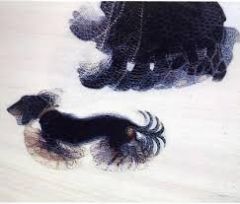
|
Balla Futurism "Dynamism of a Dog on a Lesh” 1912 -movement —> modern photography - Different way of movement over a period of seconds - The viewer is static and the image is moving - Dynamism—> futuristic movement in spacesuggests rapid motion |
|
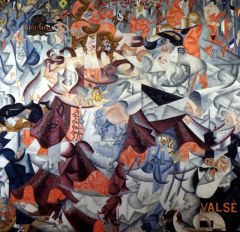
|
Severini Futurism “The Dynamic Hieroglyphic of Bal Tabarin"- 1912 -analytical and synthetic cubism -two women figures -dance hall —>”Pollca” in painting -cubist/orphistmovement of dancers (dress moving/ flowing around) |
|
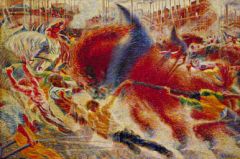
|
Boccioní Futurism “The City Rises” -1910 - fire horses are dragging water to put out the fire -fascisim impressionistic brushwork -arbitrary color |
|
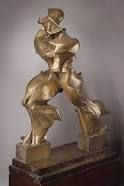
|
Boccioní Futurism “The Unique Forms of Continuity in Space”- 1913 -the cape is moving understanding the new way people are making sculptures |
|
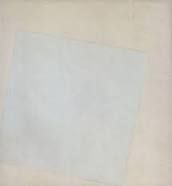
|
Malevich Futurism “White on White”- 1918 -delicate nature of tones and colorshows depth -figure is either coming out or advancing or its a hole -artist is trying to show you 3D shape, figure, and groundsimplification -supremativisim -oil on canvas -establishes three phases of supremativism white= concept of infinitymovement/ balance |
|
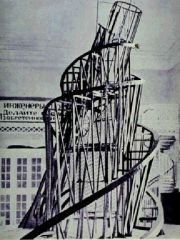
|
Tatlin- Russian Constructivism Futurism Maquette- small scale sculpture of a large scale product “Monument to the Third International”- 1919 -designed originally as a government buildinginside the structure are three floors- (spinning levels) -built for Russian propaganda |
|
|
DADA |
DADA- random events that affect society -very organic shapes random -biomorphic- having to do with biology/ tissue, organic looking |
|
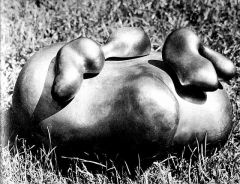
|
ARP DADA "Head with three annoying objects"- 1930 - biomorphicrandomthe forms/ objects have no meaning -cast in bronze later onstatue is supposed to be moved |
|

|
Duchamp (as a DADA artist) “Fountain”- 1917 -uses readymades- made out of found objects -urinal has been turned overmade as a sculpture -signed it as R. Mutt |
|
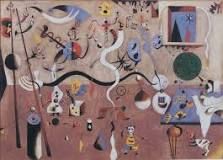
|
Miro DADA “Harlequin’s Carnival”- 1924 table, ladder, windoworganic lookingbiomorphic -out of this universefantasy/ dreamlike state - influenced by Children’s art |
|

|
Dali DADA “The Persistance of Memory”- 1931 -painted as a miniaturist (in a very small and well defined way, cannot see the brushstroke) - background/ sky is very naturalforeground- biomorphic/ organic material (suppose to be of a face) -In Dali’s world Clocks are movable and applicable -bugs flies- cycle of life nightmarish -important because it has these answers (many different interpretations/ possibilities of the significance) |
|

|
Dali DADA “Soft Construction with Boiled Beans”- 1936Bombings of Guernica- Fransico Franco chose for his own country to be bombed in WWII as a power movescene of suffering -Distorted/ horrible figure demonstrated the pieces of war -naturalistic background -in the foregroundlower torso of the bodyradio- where people would hear the news of the bombings -beans- staple of the people of Spainincludes a portrait of Sigmund Freud- a part of his life |
|
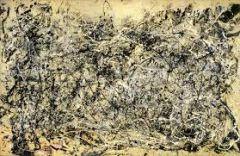
|
Pollock Abstract Expressionism “Number 1” - 1950 medium: oil, enamel, and aluminum on canvas -did not “gesso” his canvases, the painting would break apart and fall off -drip paintingpainting is related to Lucifer (the devil)—> red dripschaos in the world & the chaos inside of pollock -influence of southwest sand painting |
|

|
DeKooning Abstract Expressionism “Woman, 1” - 1950-52 -oil on canvas - frantic brushwork -image depicts whether or not he hated or loved woman |
|
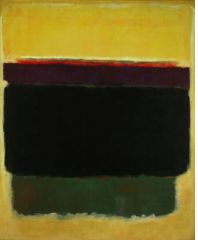
|
Rothko Abstract Expressionism “Untitled”- 1949 - large blocks of saturated colorhas a lot of yellow in it -color field -depression - painting is suppose to be optical and movingthe interaction of the rectangles (shapes) thin translucent washes of paint- built up richness of colormeant to be layers upon layers of color saturation |
|
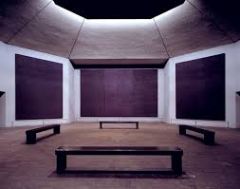
|
Rothko Abstract Expressionsim “Rothko Chapel”- 1971 color field- color is saturated all over the composition -look at this art as a meditativemedievalnon objective/ contemporary art |
|
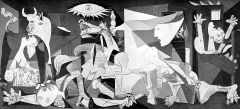
|
Picasso Abstract Expressionism “Guernica”- 1937 picasso’s understanding of what it felt like to be in the bombings -use black & white- bc in that time everyone heard about news through the newspaper -in this composition, he tries to show the horrors of warpeople screaming or in distressbodies appear to have no bone structurefallen soldierhorse is screamingwoman is holding “the lamp of truth” - heavy triangledead child and mother is screaming -bull= Spain/ picasso views himself as a bull |
|
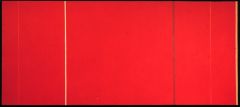
|
Barnett Newman Abstract Expressionism “Man, heroic and sublime”- 1950 timeline of mancolor field- saturatedvertical lines called zipsred= passion of color |
|

|
Warhol Pop Art “Campbell’s Soup Can”- 1962 Synthetic polymer paint on thirty-two canvases -lined up as if it was on a supermarket shelf -mimicked the repetition and uniformity advertising by carefully reproducing the same image across each individual canvas. -only variety is the label of each soup can |
|
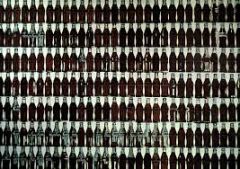
|
Warhol Pop Art “210 Coca-Cola Bottles”- 1962 -silkscreen ink on synthetic polymer paint on canvas -“a coke is a coke and no amount of money can get you a better Coke than the one the bum on the corner is drinking” -lined up as if it was on a supermarket shelf |
|
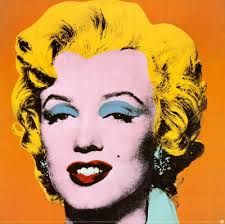
|
Warhol Pop Art “Marilyn Monroe”- 1962 used photo-silkscreen process- a printmaking technique originally invented for commercial use- becomes his signature medium and link his art making methods more closely to those of advertisements -encouraged observers to contemplate the fate of the recently deceased Marilyn Monroe |
|
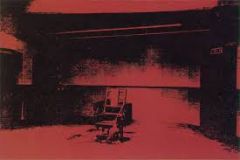
|
Warhol Pop Art “The Electric Chair”- 1964 -screenprinted with acrylic and silkscreen ink on linen - unoccupied electric chair set in an empty room -monochromatic colors |
|
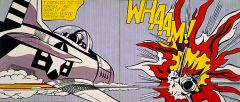
|
Roy Lichtenstein Pop Art “Whaam!”- 1963 oil and magna on two canvas panels - preferred to represent violent action and sentimental romance in his work - attracted to the way highly emotional subject matter could be depicted using detached techniques -explored the formal qualities of commercial imagery and techniques use of Benday dot technique |
|
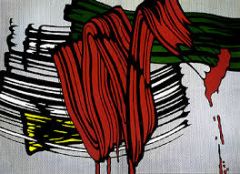
|
Lichtenstein Pop Art “Big Painting No. 6”- 1965 oil and magna on canvaspart of the brushstrokes series -shows the physical qualities of the brushstroke -example of the use of overlapping forms -black outlines of strokes are void with certain elements of depth -use Benday dot technique |
|
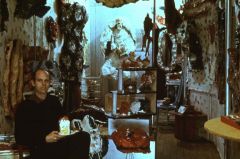
|
Claes Oldenburg Pop Art “The Store”- 1961 -sculpture -wall-mounted reliefs depicting everyday items like shirts, dresses, cigarettes, sausages, and slices of pie. - made from armatures of chicken wire with plaster-soaked canvas and enable paint |
|
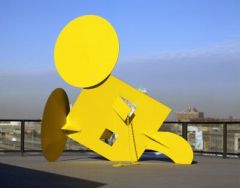
|
Oldenburg Pop Art “Geometric Mouse, Scale A.”- 1969 |
|
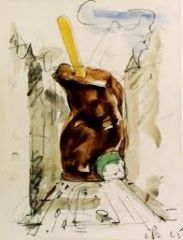
|
Oldenburg Pop Art “Proposed Colossial Monument for Park Aveune, New York: Good Humor Bar”- 1965 -crayon and watercolor on paper |

